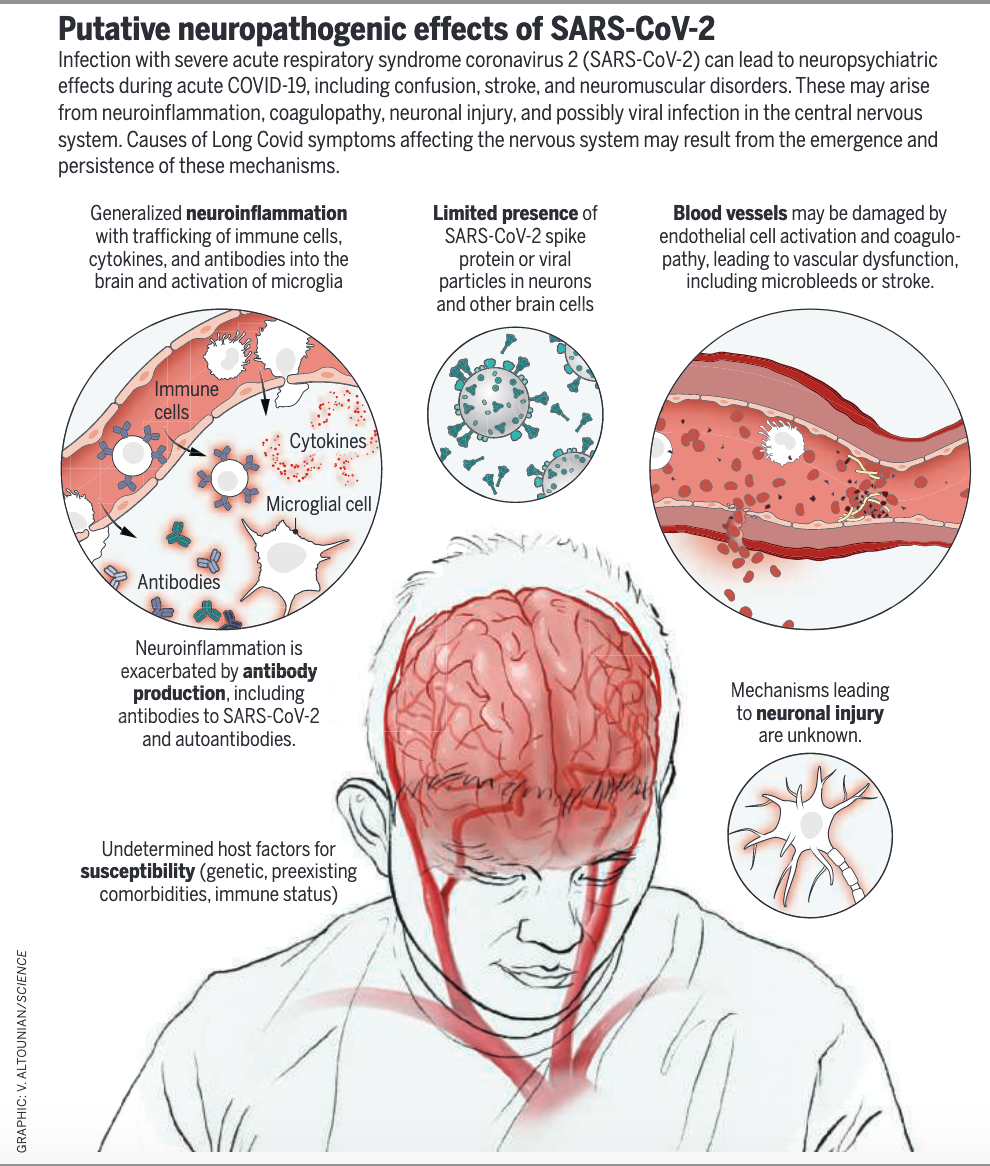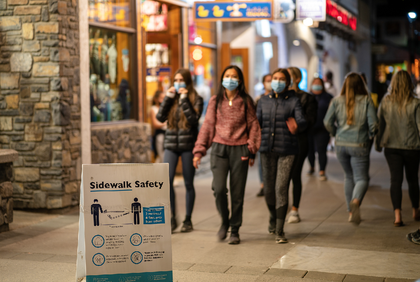|
Despite early speculation that SARS-CoV-2 may enter the central nervous system (CNS) via migration through the nasal cavity and the olfactory pathway or trafficking across the blood-brain barrier, analysis of cerebrospinal fluid (CSF) from living patients with neuropsychiatric manifestations has almost uniformly failed to detect viral RNA by reverse transcription polymerase chain reaction. Instead, the preponderance of evidence from CSF and brain tissue suggests that immune activation, intense neuro- inflammation and vascular damage within the CNS are the primary drivers of neurologic disease in acute COVID-19 and long COVID including some individuals who may be experiencing issues post vaccine. Autopsy studies of patients with acute COVID-19 show infiltration of macrophages, CD8+ T lymphocytes in perivascular regions, and widespread microglial activation throughout the brain. Generalized vascular dysfunction, including thrombotic microangiopathy (microscopic blood clots) in the brain, may lead to neurological symptoms. We worry that neuroinflammation and neuronal injury in Long COVID may accelerate or trigger future development of neurodegenerative diseases such as Alzheimer’s, Parkinson’s, ALS, etc. In this diagram, we see some of the mechanisms on going including: Viral fragments including spike protein provoking a. Neuroinflammation b. Vascular inflammation, clotting, risk of bleeding c. Microglial cell activation d. Autoantibodies formed misdirected to body/ brain tissue e. Neuronal injury and death f. In Long Covid, there has been no whole viral genome found Long COVID: "Viral reservoir" of spike protein may explain long-term symptoms Spike protein lingers.
Some studies have shown that spike protein can be found in blood in Long Covid for up to 12 months. Also, you’ll find a number of other studies (listed below) also showing that spike protein lingers in our system, such as in a subset of monocytes for up to 15 months, in exosomes up to 4 months and mRNA lingers in lymph nodes for at least 2 months. With each vaccine injection, billions of mRNA molecules wrapped in a lipid nanoparticle are injected into the body sending a genetic code to tell your body to start making trillions of spike proteins. In a study of long COVID published March 13, 2022, in the Annals of Neurology, UC San Francisco researchers identified biomarkers present at elevated levels that may persist for many months in the blood of study participants who had long COVID with neuropsychiatric symptoms. The analysis detected much higher average levels of two SARS-CoV-2 viral proteins they measured – the nucleocapsid protein and the spike protein – in blood plasma samples collected between six and 12 weeks after diagnosis from patients infected with COVID who had neuropsychiatric symptoms in comparison to samples from those who had long COVID, but who did not have neuropsychiatric symptoms. Levels of these proteins from neuronal exosomes in long COVID patients without neuropsychiatric illness were still higher than levels from patients without long COVID. A Japanese bio-distribution study for the Pfizer vaccine found that, in the 48 hours post-vaccination, vaccine particles had travelled to various tissues throughout the body and did not stay at the injection site, with high concentrations found at the liver, bone marrow, and ovaries. Alarming results show that spike protein impairs our cells’ ability to repair DNA and that segments of SARS-CoV-2 Viral RNA can become integrated into human genomic DNA. No one knows if this is transient or permanent damage to our DNA. In order to treat PASC, we must reduce the toxic burden accumulating in the body and brain from the downstream effects of spike protein. There is concern, given the lingering presence of S1, that with repeated injection of the genetic COVID vaccines, that some patients will not be able to clear this toxic protein. No one knows what the long-term effects of this will be given there have been no long-term studies and we are sorely lacking data tracking from our agencies. Links to other research with similar results include: https://www.medrxiv.org/content/10.1101/2022.06.14.22276401v1.full-text Persistent circulating SARS-CoV-2 spike is associated with post-acute COVID-19 sequelae https://www.ncbi.nlm.nih.gov/pmc/articles/PMC8273732/ Immune-Based Prediction of COVID-19 Severity and Chronicity Decoded Using Machine Learning https://www.jimmunol.org/content/207/10/2405 Cutting Edge: Circulating Exosomes with COVID Spike Protein Are Induced by BNT162b2 (Pfizer–BioNTech) Vaccination prior to Development of Antibodies: A Novel Mechanism for Immune Activation by mRNA Vaccines https://www.ncbi.nlm.nih.gov/pmc/articles/PMC8538446/ SARS–CoV–2 Spike Impairs DNA Damage Repair and Inhibits V(D)J Recombination In Vitro https://www.pnas.org/doi/10.1073/pnas.2105968118 Reverse-transcribed SARS-CoV-2 RNA can integrate into the genome of cultured human cells and can be expressed in patient-derived tissues https://www.mdpi.com/1467-3045/44/3/73/htm Intracellular Reverse Transcription of Pfizer BioNTech COVID-19 mRNA Vaccine BNT162b2 In Vitro in Human Liver Cell Line https://www.medrxiv.org/content/10.1101/2021.05.03.21256520v1 The BNT162b2 mRNA vaccine against SARS-CoV-2 reprograms both adaptive and innate immune responses
0 Comments
Your comment will be posted after it is approved.
Leave a Reply. |
AuthorSuzanne Gazda M.D. Neurologist Archives
January 2024
Categories |




 RSS Feed
RSS Feed